Appendix 1: Foundation Programs 2011-2015 summaries and outcomes

1. TARDIS II: DEEP-EARTH FLUIDS IN SUBDUCTION ZONES, OPHIOLITES AND CRATONIC ROOTS
Themes 1, 2 and 3, Early Earth, Earth's Evolution and Earth Today, contributing to understanding Earth's Architecture and Fluid Fluxes.
AIMS
This program investigates aspects of deep subduction during continental collision, ophiolite fragments that get caught up in the subduction environment, and the role of fluids in the deep mantle and lithosphere. Super-reducing, ultra-high-pressure (SuR-UHP: 400-600 km) mineral assemblages in selected ophiolites carry implications for the evolution of fluid compositions, reactions and redox states in subduction environments from the surface to the Transition Zone, and suggest a new geodynamic collision process that may improve mineral exploration concepts for paleosubduction regimes. The recent discovery of similar ultra-reduced mineral assemblages in ejecta from Cretaceous volcanoes in Israel suggests a previously unrecognised process of interaction between deep-mantle fluids and ascending basaltic magmas. We aim to determine the extent of isotopic fractionation in a range of elements caused by redox reactions that produce many oxygen-free phases at UHP conditions. Goals are to produce an experimentally testable model for the generation and preservation of highly reducing conditions in the mantle, to quantify constraints on the geochemical and tectonic processes that have produced SuR-UHP assemblages, and to produce a geodynamic model for these processes.
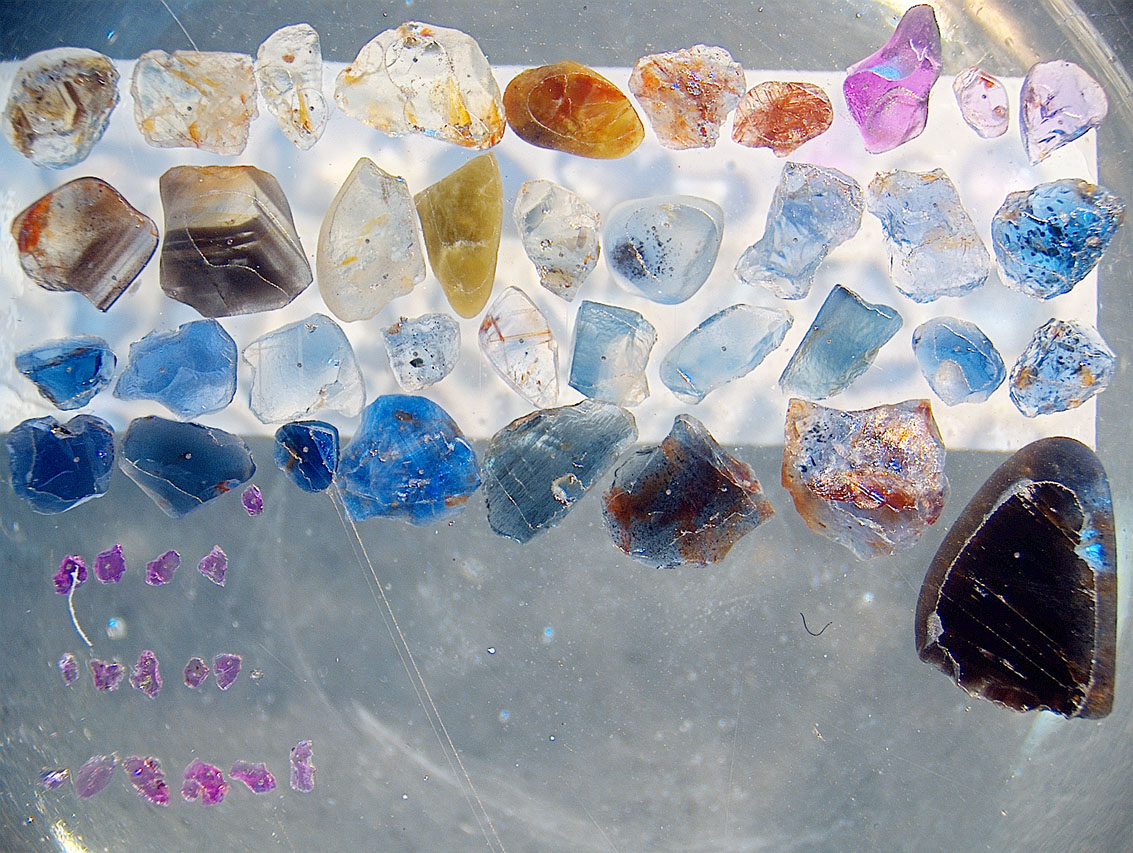
Corundum (including sapphires and rubies) ready for polishing to examine inclusions, trace elements and isotopes.
UHP rocks, lithospheric diamonds and the Israeli volcanics will be used to refine the geochemical signatures of deep fluids and microstructural histories to provide additional insights into deep-mantle fluid types and processes. The isotopic variability of carbon, oxygen, nitrogen and sulfur in diamond-forming fluids will be studied to ascertain whether these are primary signatures, or are produced by isotopic fractionation during diamond growth.
2015 REPORT
Several major studies of ophiolitic chromitites were finished and are published or in press, defining a model for generation of chromitites by magma mixing, new ideas for the mechanisms of PGM inclusions in chromites, and the behaviour of chromitites and PGMs during thermal and regional metamorphism and deformation.
A comprehensive investigation of microstructures and mineralogy in Tibetan ophiolites has defined their evolution, including formation in ancient SCLM within subduction-zone settings, followed by subduction into the upper transition zone and exhumation to the sea floor prior to final emplacement by thrusting during continental collision.
Detailed isotopic and geochemical studies provided evidence that the diamonds found in Tibetan and Uralian ophiolites represent a previously unrecognised environment of diamond formation, and not anthropogenic contamination.
Studies of zircons in Australian and Tibetan ophiolites produced strong evidence that the zircons and other crustal minerals are introduced into the peridotites of the ophiolites during emplacement into the crust, and are not part of the mantle. Detailed method development allowed demonstration that extreme isotopic fraction of Li in zircon is related to late diffusion.
Techniques were developed for the in situ analysis of Si and C isotopes in SiC (moissanite) by SIMS, allowing a new evaluation of the formation environment of SiC in the mantle.
Ed Saunders' work has put new constraints on the abundance, residence and mobility of Au in the mantle. Mathieu Chasse has begun a project on the behaviour of Scandium in lateritic weathering profiles on mafic-ultramafic rocks.
Petrological studies on the Cabo Ortegal complex (Portugal) are building up a picture of the rarely-seen sub-arc mantle and its mafic rocks.
A number of xenolith studies added new data allowing improvement of a comprehensive picture of the deep crust and upper mantle beneath the North China Craton and other parts of Asia, as well as the Pannonian Basin.
Studies of ejecta (corundum aggregates) from Israeli volcanoes identified a suite of highly reduced phases, implying the mixing of deep-mantle fluids (dominated by CH4 + H2) with mafic magmas.
See Research Highlights pp. 37-38, 39, 53-55, 63-64, 70-71
Published outputs for 2015
CCFS Publications: #348, 502, 519, 522, 523, 607, 525, 532, 533, 591, 593, 610, 611, 614, 622, 631, 640, 647, 650, 651, 653, 654, 673, 674, 678, 690
22 Conference Abstracts

2. MULTI-SCALE FOUR-DIMENSIONAL GENESIS, TRANSFER AND FOCUS OF FLUIDS AND METALS
Themes 2 and 3, Earth's Evolution and Earth Today, contributing to understanding Earth's Fluid Fluxes.
AIMS
This program takes on a holistic approach to ore deposit research, acknowledging that the genesis of mineral occurrences required the conjunction in time and space of three main independent parameters, including fertility, lithosphere-scale architecture, and favourable transient geodynamics. In this context, this study tests the hypothesis that the genesis of sizeable mineral deposits is the end product of self-organised critical systems operating from the scale of the planet all the way to the very focused environment where ore deposits can form. The principal aim is to address the critical link between metal source fertility and four-dimensional evolution of multi-scale fluid pathways that ensure efficient mass and fluid flux transfer between the mantle and the upper crust.
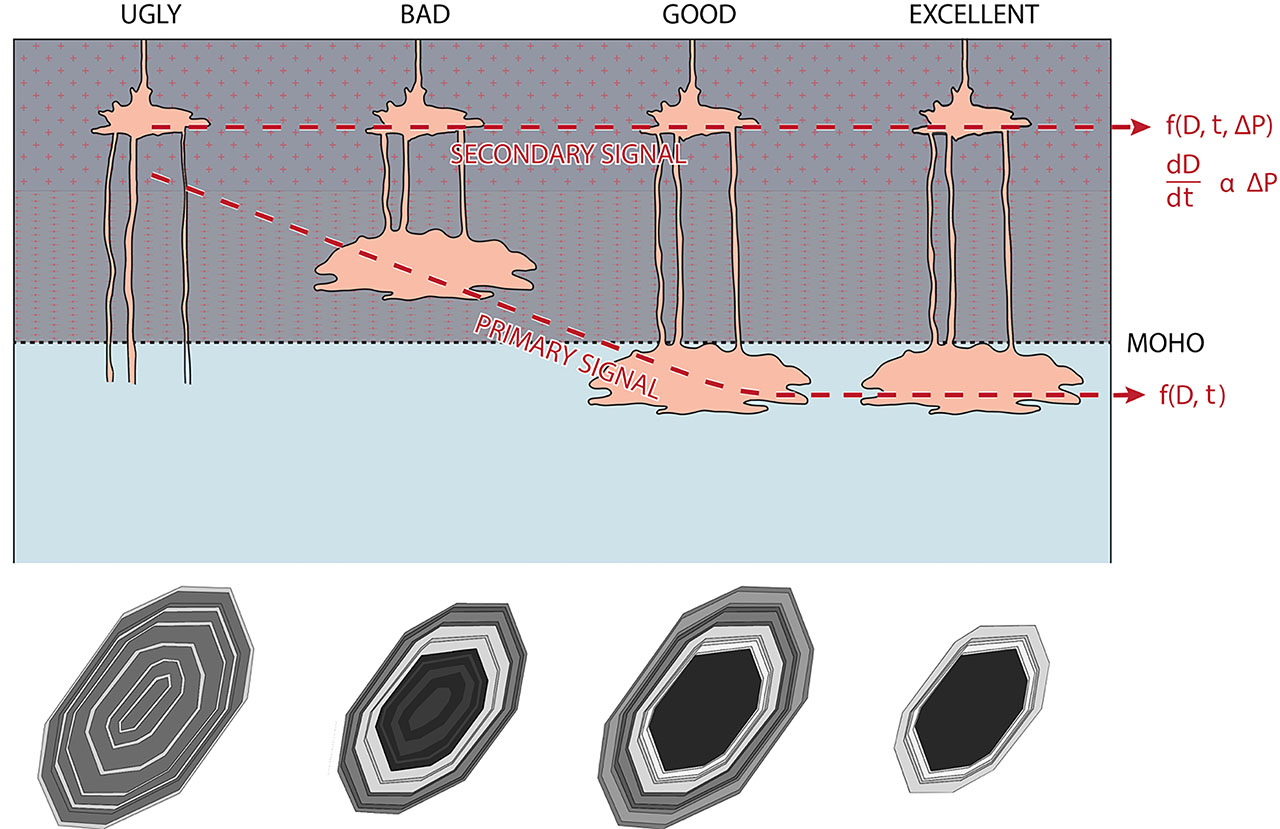
Figure 1. Schematic showing four end member scenarios in the subduction-related porphyry mineral system framework. According to the lithospheric architecture and geodynamic setting of any specific scenario, and depending upon the relative efficiency of differentiation and volatile-saturation processes, these systems may either evolve towards the formation of barren porphyries or to the creation of world-class mineralised camps. Most importantly, the zircon grains crystallising from magmatic systems that underwent these different processes in a range of tectono-stratigraphic settings may have distinct morphological, chemical and isotopic characteristics. These may be preserved in the detrital record and be useful in targeting high quality magmatic-hydrothermal copper, gold and molybdenum deposits.
2015 REPORT
Progress in 2015 has been formidable, with steady advances in the 3 Modules that make up the framework of the Flagship Program.
Module 1 (Fertility) included (1) studies focused on the Thrym Complex of southeastern Greenland and on the Ivrea Zone of northwest Italy to unravel the transport mechanisms of volatiles and metals in the lithosphere, and (2) studies to improve our understanding of the emplacement dynamics of mineralised porphyry systems, which showed that zircon can discriminate between metallogenically fertile and infertile arc igneous complexes and intra-plate granitoids. Module 2 (Architecture) has focused on three key areas that display significant metal endowment in both Archean and Proterozoic terranes: western Superior Craton, West Africa Craton and North Australia Craton. The project in the Western Superior Craton, which is the main focus of the PhD project of Katarina Bjorkman, will successfully conclude in late 2016, with the delivery of an isotopic map that displays the 4D evolution of the Wabigoon Terrane. In the North Australia Craton (NAC), the PhD project of David Stevenson (completing late 2016) targeted undiscovered mineralised regions under cover within the NAC and employed the methods generated during this study to elucidate architectural controls on mineralisation within covered terranes globally. The PhD project of Linda Iaccheri (completing late 2016) focused on generating new oxygen and Hf isotope compositions of detrital zircons from 1.8 Ga turbidites from the North Australia Craton. In the West Africa Craton, the study focused on unravelling the geodynamic and mineral system evolution through a systematic lithostratigraphic compilation throughout the various investigated terranes. Finally, outcomes from Module 3 (Transient Geodynamics) provided a solid foundation for a better understanding of host rock rheology on the emplacement dynamics of mantle derived magmas, and the variable geometries of the intrusions that are observed in nature.
See Research Highlights pp. 45, 49, 57, 62, 68, 72-73, 74-75
Published outputs for 2015
CCFS Publications: #463, 508, 531, 587, 592, 616, 620, 630, 639, 644, 657, 660, 682, 686
9 Conference Abstracts

3. TWO-PHASE REACTIVE FLOW IN MULTI-COMPONENT DEFORMABLE MEDIA
Themes 2 and 3, Earth's Evolution and Earth Today, contributing to understanding Earth's Architecture and Fluid Fluxes.
AIMS
The overarching goal of this program is the development and application of in-house state-of-the-art computational simulation tools to model complex geochemical-geodynamic processes involving two-phase reactive flow in multi-component deformable media. Many aspects of Earth Science, from ore deposits to giant earthquakes, depend critically on the complex interaction of solids and fluids. Numerical simulation of these processes and effective visualisations of the results is critical to understanding how these Earth system components work, but our ability to do this is currently very limited. Flagship Program 3 is developing the next generation of numerical codes and refining thermodynamic parameters by high-pressure experiments to handle these complex problems. This will lead to important improvements in the quantification and visualisation of Earth processes, and will be applied to a variety of geodynamic situations. The new experimental group at Macquarie joins this initiative to provide input on physico-chemical parameters of minerals and fluids in the deep mantle, the composition of melts that infiltrate the lithosphere, and their effects on its geodynamics and stability.
2015 REPORT
This year saw the development of full global, high resolution runs with a modified version of the code "Aspect". We have also completed coding and testing of melting, devolatisation and melt depletion of the mantle. Our first papers with the new global models have been published ( CCFS Publication #675), illustrating the effect of evolving planetary systems on core evolution.
A refined method for handling multiphase/component flow has been developed and benchmarked, and the technique was published by Oliveira et al. ( CCFS Publication #685). An efficient algorithm for implementing thermodynamic information into geophysical inversions and geodynamic simulations has been completed (CCFS Publication #668). A true two-phase multicomponent reactive flow numerical framework was successfully completed in 2015 and presented at the Workshop "From Foundations to State-of-the-Art in Magma/Mantle Dynamics" in Cambridge in 2016.
A 3-D crustal and upper mantle S-wave velocity model of northeastern China is being constructed using inversion of phase velocity dispersion curves at 6-140 s periods from ambient noise tomography and two-plane surface wave tomography. Built upon the observed velocity anomalies, we propose a sub-lithosphere mantle convection model for northeastern China. This work is published in CCFS Publication #578.
The expansion of the high-pressure experimental facilities continued in 2015, with plans for an extension to the laboratory in a new wing. This will house two large multi-anvil presses, and a third will be installed in the current laboratory. Laser-heated diamond anvil cells and an additional piston-cylinder apparatus will be acquired in 2016 through LIEF funds from the Australian Research Council. An experimental program on electrical conductivity in mantle materials has begun with the currently available multi-anvil apparatus.
See Research Highlight pp. 43-44
Published outputs for 2015
CCFS Publications: #578, 656, 668, 675, 685, 706
13 Conference Abstracts

4. ATMOSPHERIC, ENVIRONMENTAL AND BIOLOGICAL EVOLUTION
Themes 1 Early Earth, contributing to understanding Earth's Architecture and Fluid Fluxes.
AIMS
CCFS Flagship Program 4 investigates how the evolution of life and ore deposits were linked to the changing energy state of the whole-Earth System over time, focusing on planetary driving forces that affected all of the different shells of the planet through time, to develop a 4-dimensional conceptual framework of Earth's Evolution. In addition, we apply these Earth-based studies to a better understanding of the evolution of our nearest planetary neighbour, Mars, to guide our understanding of its geological evolution and the search for life within its crust.
Earth's crust represents a complex and dynamically evolving chemical interface between two convective fluid systems: the endosphere (linked core and mantle) and the exosphere (linked hydrosphere and atmosphere). This program investigates how the energy available from the sharp chemical and thermal gradients that exist across this interface changes over time and contributes to the formation of ore deposits, and to the changing nature of atmospheric, environmental, and biological evolution that are linked to the supercontinent cycle.
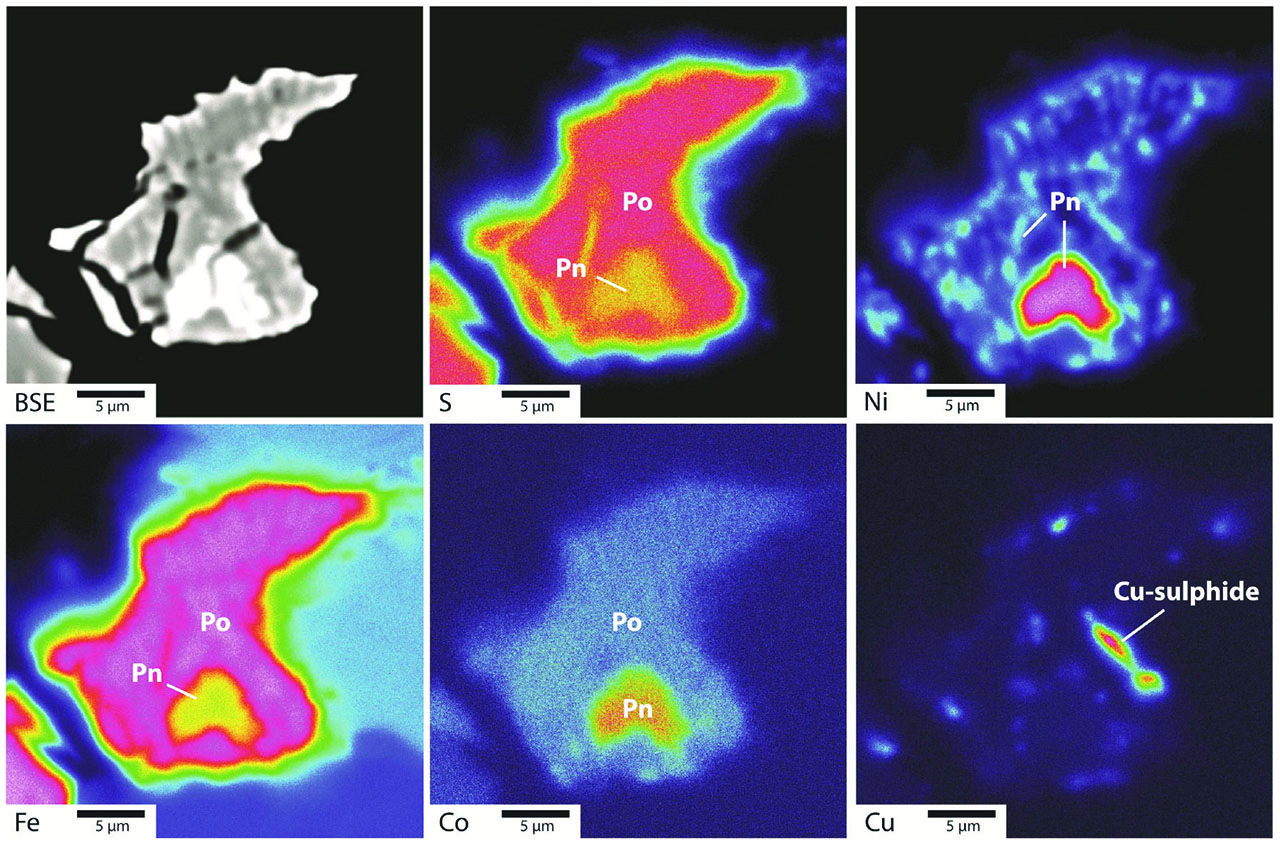
FP4: WDS X-ray elemental distribution map showing a sulfide grain in the olivine-phyric Shergottite Dhofar 019. The sulfide grain is composed of pyrrhotite, with a coarse Co-rich exsolution of pentlandite, as well as a Cu-rich sulfide phase, probably chalcopyrite or cubanite.
2015 REPORT
FP4 research concentrates on evaluation of the relative importance of (1) the threshold barriers that form in specific environments creating strong chemical and energy gradients in the crust, and the self-organised behaviour of mineral systems and life; (2) the evolving nature of the "traps" at the lithosphere-hydrosphere boundary, where life and ore deposits developed through time, as a mechanism to breach these threshold barriers (and to be preserved); (3) the global scale cycle of key chemical elements and heat transfer deemed essential for the evolution of life and formation of ore deposits; and (4) the 4-D evolution of the planetary system and the associated pathways that connect different geochemical reservoirs through time, linked to the changing tectonic style of the planet.
Research activity in CCFS Flagship Program 4 involves primarily cross-node cooperation between UNSW and UWA associated with many external collaborators and concentrates on early Earth processes. Several sub-projects are currently under way:
(1) Geochemical and stable isotopic compositions of carbonate minerals in Pilbara greenstones from well constrained environmental conditions as a guide to early Earth fluid compositions;
(2) 3.7 Ga stromatolites from Isua, Greenland, as a new benchmark for the oldest evidence of life on Earth;
(3) A study of hotsprings and geysers in the stromatolitic 3.48 Ga Dresser Formation (Pilbara), which are providing new evidence of early life having thrived in hotpsrings on land;
(4) The role of microbes in the precipitation of "buckshot" pyrite and gold in the 2.76 Ga Hardey Formation, Fortescue Group, Pilbara;
(5) Adaptation of the biosphere to the rise of atmospheric oxygen, using a well preserved unit from the 2.4 Ga Turee Creek Group in Western Australia;
(6) A study to quantify possible sources of contamination in organic geochemical studies of Archean and Proterozoic rocks;
(7) The role of the supercontinent cycle in changing rates of energy transfer between mantle/crust and atmosphere/hydrosphere/biosphere;
(8) The implications Archean hotspring results have for the search for life on Mars;
(9) The potential of Martian magmatism for Ni-Cu-PGE sulfide mineralisation similar to those associated with the suites of mantle plume-related, mafic to ultramafic komatiites and ferropicrites on Early Earth.
See Research Highlights pp. 36-37, 50-51, 52-53, 66-67
Published outputs for 2015
CCFS Publications: #380a, 492, 498, 499, 500, 632, 636, 712, 759, 766, 768, 785
10 Conference Abstracts
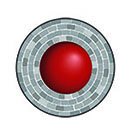
5. DETECTING EARTH'S RHYTHMS: AUSTRALIA'S PROTEROZOIC RECORD IN A GLOBAL CONTEXT
Themes 2 and 3, Earth's Evolution and Earth Today, contributing to understanding Earth's Architecture.
AIMS
Earth's history is considered to have been dominated by cycles of supercontinent formation and breakup. This program tests this hypothesis and its relevance to Australia's geological evolution and assesses its positions during the supercontinent cycles by examining the paleomagnetic, petrological and detrital provenance record of the Australian continent. By comparing Australian rocks with global analogues, we aim to extend our knowledge about supercontinent cycles and the evolution of the Australian continent to the Paleoproterozoic and further back in time. Such knowledge is fundamental for understanding the first-order fluid cycles that controlled the formation and redistribution of Earth resources, and the establishment of a 4D global geodynamic model.
We are examining the position of the Australian continent during supercontinent cycles and its record of plume events through a multidisciplinary study of Australian rocks. We focus on the following scientific questions: (1) Was Australia neighboured by East Asian continental blocks during the assembly of Gondwanaland? If yes, which ones, and what was their collision and breakup history? (2) Was there indeed a 40° rotation between northern and southern Australia during the Neoproterozoic that led to the formation of the Paterson-Peterman intraplate orogen? (3) When and how was the Australian Precambrian basement joined together? (4) What was Australia's role in the configuration and evolution of Pre-Rodinia supercontinent(s)?
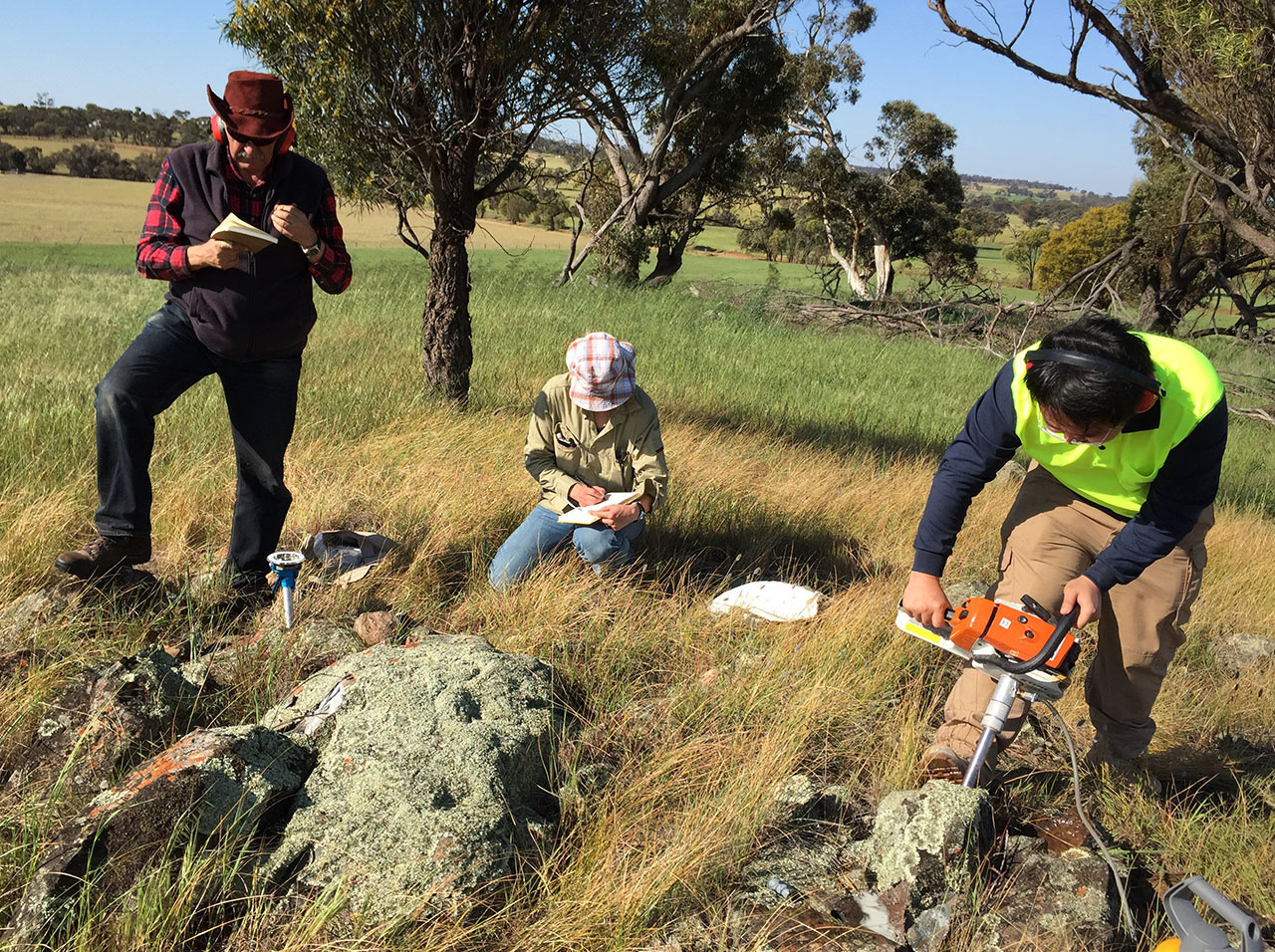
Sergei Pisarevsky, Camilla Stark and Yebo Liu sampling dykes in the Yilgarn.
2015 REPORT
New paleomagnetic data from the ~2.4 Ga Erayinia dykes in eastern Yilgarn craton led to a new reconstruction of the Paleoproterozoic Superia Supercraton ( Pisarevsky et al, 2015). We also published a global synthesis of the timing and locations of collisional and accretionary orogens, and average plate velocities as deduced from paleomagnetic and paleogeographic data over last 2.5 Ga (Condie et al, 2015). New reconstructions of São Francisco-Congo, North China and Siberia's positions in Nuna using LIP record, plus geochronology and paleomagnetic data (Cederberg et al., 2016) and first paleomagnetic data from New Siberian Islands (Russia) and a reconstruction of Palaeozoic Arctida continent (Metelkin et al., 2016) have also been completed. Pisarevsky co-edited a Precambrian Research special issue (v. 259, 2015) on supercontinental cycles and geodynamics, and Li and collaborators edited a CCFS-sponsored Geological Society of London Special Publication 424 on Supercontinent Cycles Through Earth History (http://sp.lyellcollection.org/online-first/424), which will be published in 2016.
We conducted a first sampling trip to the Yilgarn Craton. Samples from >20 new dykes, together with samples from >10 dykes previously sampled by ZX Li, are being analysed for palaeomagnetism (PhD student Yebo Liu), and geochemistry and geochronology (PhD student Camilla Stark and Hons student Sarah Champlain). Preliminary results suggest the presence of multiple Proterozoic dyke swarms in the region, and at least some of them still retain their primary magnetic remanence. More sampling is planned in 2016, and analytical work continues.
Dyke samples from Bunger Hills and Vestfold Hills of East Antarctica, obtained through national and international collaborations, are also being investigated for their ages, and geochemical and paleomagnetic signatures.
Yao conducted a field trip to examine the Ediacaran-Silurian paleogeography of the western Yangtze margin in collaboration with China Geological Survey. Provenance analysis of the Lower Palaeozoic Nanhua Basin have been published (Yao et al., 2015a,b). Work on Hainan Island and northwestern Australia are progressing well.
See Research Highlight p. 61
Published outputs for 2015
CCFS Publications: #461, 468, 469, 517, 520, 584, 590, 604, 642, 648, 687, 723, 750, 789, 790
15 Conference Abstracts

6. FLUID REGIMES AND THE COMPOSITION OF THE EARLY EARTH
Themes 1 and 3, Early Earth and Earth Today, contributing to understanding Earth's Architecture and Fluid Fluxes.
AIMS
Zircon crystals are currently the only material that records events in the first 500 million years of Earth's history, since no rocks have survived from this period and no other minerals have been established as Hadean in age. There is growing evidence from the study of these zircon crystals that the Earth stabilised rapidly after accretion and that both solid rock and liquid water were present within 150 million years of its formation. In this program, the geochemical signatures of zircon crystals from all known Hadean and early Archean localities will be utilised, together with geochemistry of the oldest known rocks and the application of geophysical and geochemical modelling, to establish how the first crust evolved, why it was destroyed and the role of fluids in this process. It will also evaluate the changes that took place throughout the Archean as crustal processes evolved. In addition, work will continue on Martian meteorites and lunar samples in order to provide further constraints on the early history of the Solar System, especially the role played by fluids.
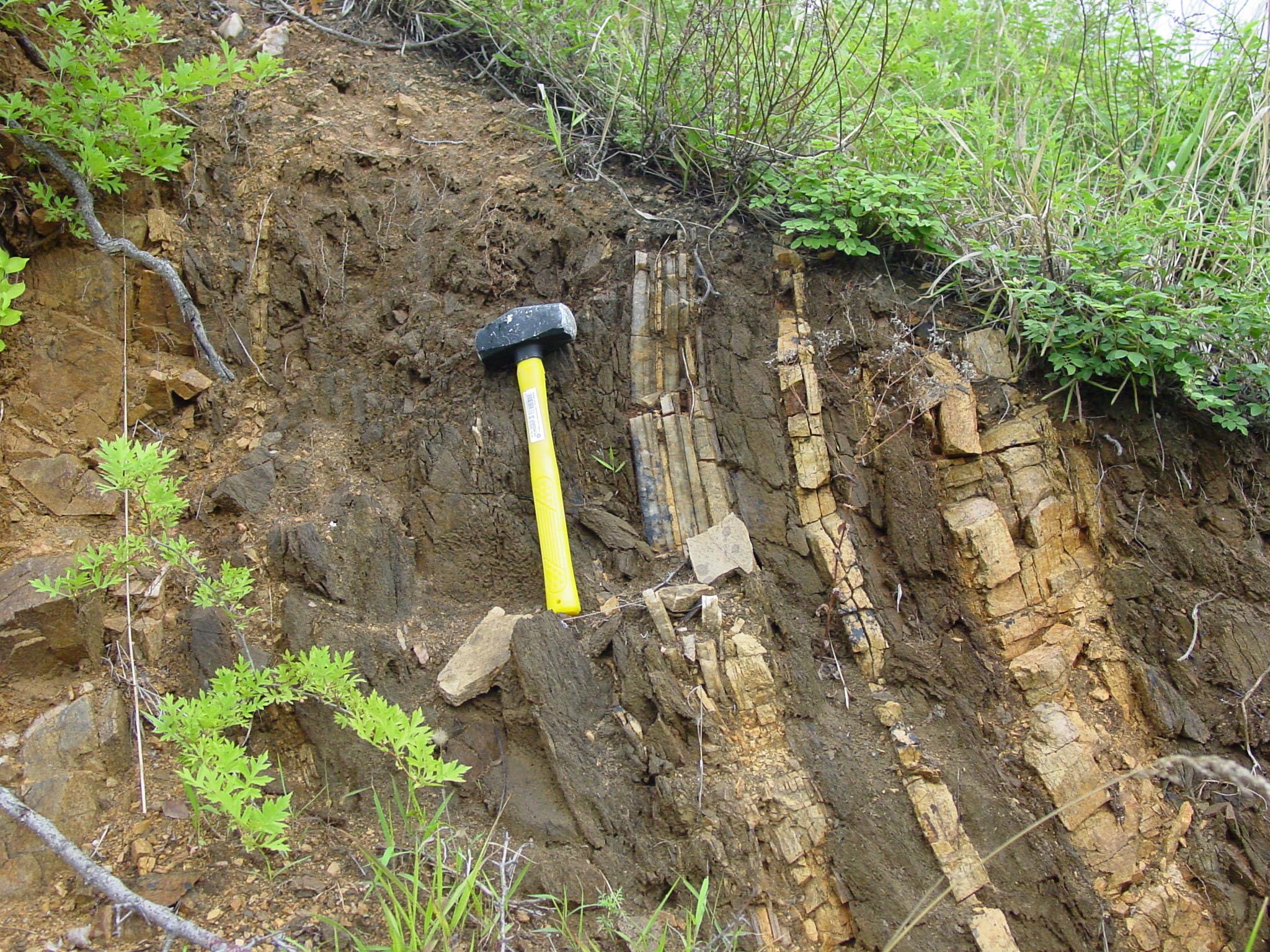
Sergei Pisarevsky, Camilla Stark and Yebo Liu sampling dykes in the Yilgarn.
2015 REPORT
Work continued on zircons obtained from Labrador and the North China Craton (NCC). Preliminary results from Labrador indicate a possible extension of the ancient gneisses. A Nd study was initiated on TTG rocks from the NCC with ages between 3.8-3.0 Ga to test for systematic variations with age. Zircon U-Pb and Lu-Hf analyses were undertaken on samples from Aker Peaks in Kemp Land, Antarctica. The presence of nanospheres of metallic lead in Napier Complex zircons was published in the Proceedings of the National Academy of Sciences of the United States. This has important implications for the veracity of U-Pb ages of zircon, especially in rocks that have undergone more than one episode of high-grade metamorphism.
Work continued on the Tarim Craton in association with Nanjing University. Initial indication of 3.5 Ga zircons from the Kuruktag area of northern Tarim has been substantiated, with even older rocks discovered in the vicinity. Work on the Bundelkhand Craton in India continued in association with Prof M. Ram Mohan, with new Lu-Hf data acquired. The granitoid rocks reveal ages very similar to major granitoids developed in the NCC, suggesting a possible linkage in a late Archean supercontinent that also included the Dharwar Craton of India.
The Pb isotopic composition of minerals from Martian meteorites reveal that the least radiogenic Pb measured for each individual sample represents the Pb isotopic composition at the time of crystallisation (initial Pb). These new values define excellent negative linear correlations with ε143 Ndi, ε176Hfi, and ε182Wi and a positive linear correlation with γ 187Os i. This suggests differentiation of the Martian mantle affected all radiogenic parent-daughter ratios at a similar time. Lunar work focused on Apollo 14 samples and investigated zircon radiation damage and the age of phosphates. In addition, newly developed techniques have allowed the precise crystallisation ages (2σ errors typically within ±10 Ma) for several lunar basalts to be determined.
Published outputs for 2015
CCFS Publications: #576, 605, 641, 736, 737, 738, 749, 752, 755, 756, 784
1 Conference Abstract
3.7-3.6 Ga trondhjemite veins in biotite schist within the Baijiafen Quarry at Anshan, NE China.

7. 3D ARCHITECTURE AND PRECAMBRIAN CRUSTAL EVOLUTION IN THE WESTERN YILGARN, AUSTRALIA
Themes 1, 2 and 3, Early Earth, Earth's Evolution and Earth Today, contributing to understanding Earth's Architecture.
AIMS
Iron, Gold and Nickel deposits are of global economic significance, and the Neoarchean Yilgarn Craton and the Proterozoic orogens around its margins constitute one of Earth's greatest mineral treasure troves. Whereas the Yilgarn is one of the best-studied Archean cratons, its enormous size and limited outcrop are detrimental to a deep understanding of what controls the distribution of resources and which geodynamic processes were involved in the tectonic assembly of the Australian continent. The principal aim of this program is to combine geological, geochemical and geophysical techniques to propose a 3D structural model of the lithosphere of the Yilgarn Craton and its margins.
The Yilgarn Craton is a large and highly complex piece of Archean crust with a long history extending from 4.4-2.6 Ga. Amalgamation of terranes is thought to have occurred around 2.65 Ga. Recent work by GSWA in the northwestern part of the craton has identified a long-lived, autochthonous history of crustal development there. There is a growing realisation that understanding how mineralised crustal provinces form requires structural and chemical information on the entire lithosphere. This is addressed in the multi-disciplinary SIEF project "The Distal Footprints of Giant Ore Systems: UNCOVER Australia", which involves collaborative research between CSIRO, UWA, Curtin and GSWA, and targets the Capricorn Orogen at the northern boundary of the Yilgarn.
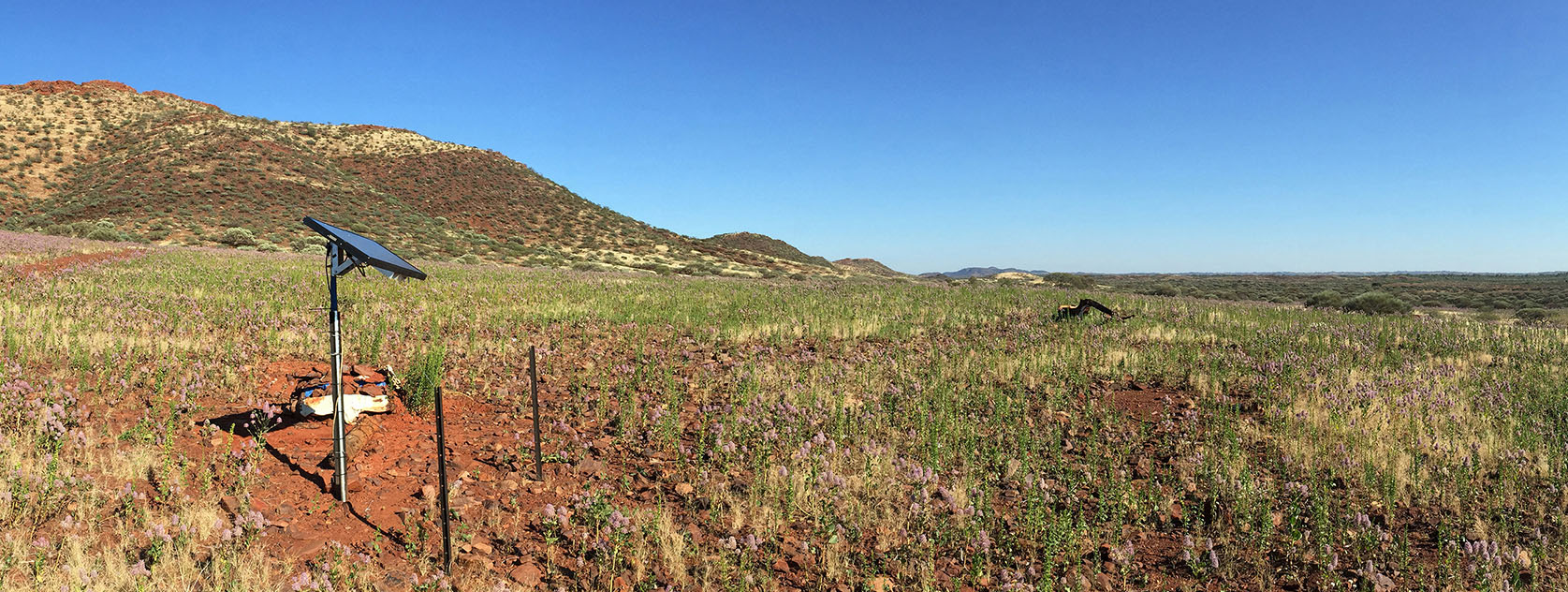
A typical view of a passive seismic station in the COPA experiment; Ashburton Basin, Western Australia.
It includes the Capricorn Orogen Passive Array (COPA), a passive source experiment that will study the structure of the deep crust and shallow lithosphere using earthquake seismology. The data from this experiment will be the main source for the local ambient noise inversion, the receiver function common convection point (CCP) stacking techniques, and possibly a body-wave tomography study. Given the fact that the passive source site coverage in Western Australia is sparse and that the available permanent sites in the region provide nearly 10 years of data at isolated locations, several techniques that focus on crust and upper mantle structure beneath single stations will also be applied. This approach has the potential to provide quick access to the crustal and lithospheric structure from these representative sites.
2015 REPORT
Huaiyu Yuan produced preliminary maps of the crustal structure in the Capricorn Orogen using seismic receiver functions. The maps show bulk crustal thickness, Vp/Vs ratio, bulk crustal Vp velocity and the crustal density anomaly from gravity inversions. First results show that the crust in the western Capricorn Orogen is thicker, denser and seismic velocities are faster than in the two cratons. The composition of the western Capricorn Orogen is complex, and the results may indicate different terranes or deformation processes during the amalgamation of the Western Australian craton during the Proterozoic. The northern margin of the Yilgarn craton shows anomalous thicker, denser and high speed crust, with an abrupt change in crustal conductivities that are also observed in magnetotelluric studies.
Ruth Murdie and Klaus Gessner, in close collaboration with the Geological Survey of Western Australia's (GSWA) Editing and Publishing team have produced the first 3D geology digital models that are now available to the exploration industry and the public from the GSWA bookstore. The GSWA's 3D Geomodels include 3D objects as well as the full 2D digital data suite of GSWA's standard digital map packages. The two regions GSWA has modelled, Sandstone and Windimurra, have known deposits of vanadium, and gold, and the models will enhance future exploration potential for more gold, platinum group elements, nickel, and copper.
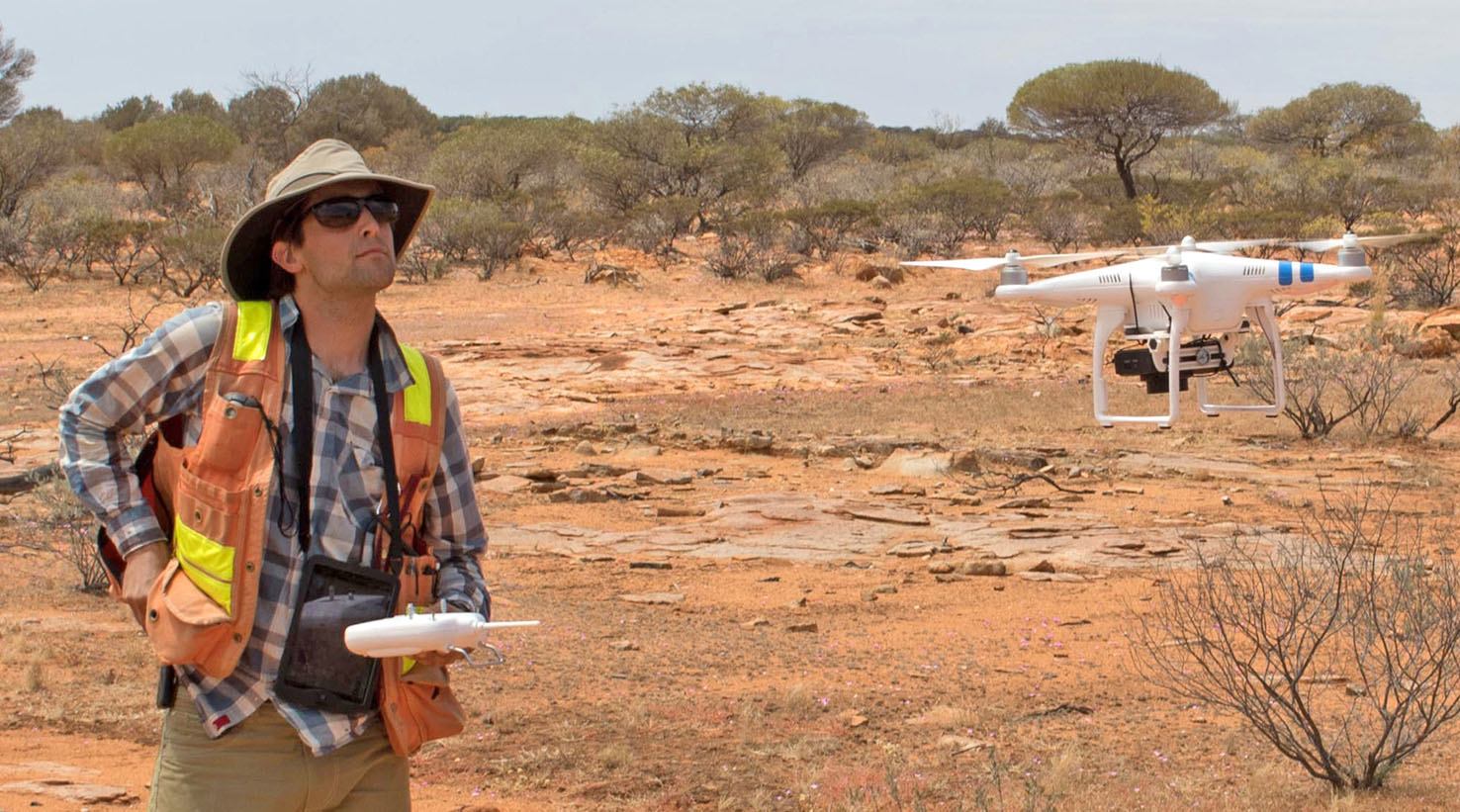
Greg Dering controls the Phantom 2 UAV during photogrammetric imaging of the Moyagee Fault near Cue, Western Australia.
PhD student Greg Dering is involved in field work in the Yilgarn Craton with Ivan Zibra (GSWA), Joseph White (University of New Brunswick), and Klaus Gessner (GSWA). Greg used his unmanned aerial vehicle (UAV)-based photogrammetric imaging approach to help map the structure of the Moyagee fault, a Neoarchean brittle-ductile shear zone in the Murchison domain, and xenoliths in the Warroan Hill granite outcrop.
Klaus Gessner co-organised an international conference on 3D geological modelling in Margaret River, Western Australia, from 2-7 August 2015: 'Saying goodbye to a 2D Earth' brought together world leading experts in the field, including key industry representatives.
At the 2015 AGU Fall Meeting in San Francisco Huaiyu Yuan and Klaus Gessner, together with Vadim Levin (Rutgers University, NJ, USA) convened oral and poster sessions on 'Characterising cratons and craton margins'.
See Research Highlights pp. 34-36, 41-42, 64-65
Published outputs for 2015
CCFS Publications: #649
11 Conference Abstracts
Whole of centre technology development

1. CAMECA ION MICROPROBE DEVELOPMENT: MAXIMISING QUALITY AND EFFICIENCY OF CCFS ACTIVITIES WITHIN THE UWA ION PROBE FACILITY
Themes 1, 2 and 3, Early Earth, Earth's Evolution and Earth Today, contributing to understanding Earth's Architecture and Fluid Fluxes.
AIMS
The Ion Probe Facility within the CMCA at UWA is one of the best-equipped Secondary Ion Mass Spectrometry (SIMS) labs in the world. It houses a CAMECA IMS 1280 large-radius ion microprobe, for the high-precision analysis of stable isotopes in minerals, and two CAMECA NanoSIMS 50s for imaging mass spectrometry at the sub-micron scale. This program provides a dedicated Research Associate to facilitate CCFS activities and lead the development of standards and analytical protocols at the CMCA. This will greatly benefit the CCFS by increasing the capacity of the Facility, enabling a higher degree of interaction and participation on research projects, facilitating standards and protocols development, and allowing greater synergy with other CCFS node facilities.
2015 REPORT
The Ion Probe Facility enjoyed a very good year in 2015, with the addition of a new NanoSIMS 50L, and several new members to the SIMS team (Heejin Jeon, Paul Guagliardo and Haibo Jiang). It was also a productive year for the IMS1280, which clocked up almost 4000 hours and contributed to more than 20 projects.
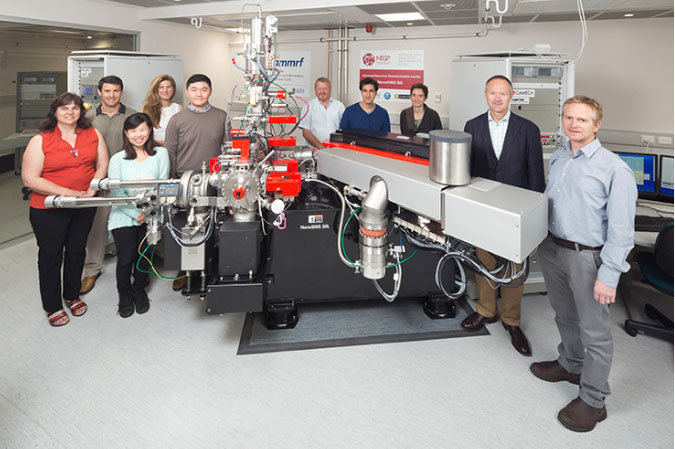
Members of UWA's CMCA with the new CAMECA NanoSIMS 50L. From left to right: Kymette Peck (NRSP), Sean Webb, Heejin Jeon, Ingrid Magtengaard (NRSP), Haibo Jiang, Peter King, Paul Guagliardo, Laure Martin, David Sampson, Matt Kilburn.
One of the most time intensive projects was the continued development of quadruple S isotope analyses (32S, 33S, 34S and 36S) in sulfide minerals. This project, initiated by John Cliff, who left the lab in 2014, and continued by Crystal LaFlamme, Laure Martin, Heejin Jeon and Matt Kilburn, has now produced a continuous data set that spans several years. A manuscript featuring the development of in-house standards for pyrite, chalcopyrite, arsenopyrite, pyrrhotite and pentlandite, is currently under review.
These protocols have been applied to a number of projects, as an exploration tool, and for Archean-Proterozoic orogens, such as the Capricorn Orogen, Western Australia (Crystal LaFlamme, Vikraman Selvaraja), and the Ammassalik Intrusive Complex, Greenland (Anne Johannesen).
High-precision O isotope analyses continue to be a staple for the lab, and were applied to U/Pb-dated zircons from igneous rocks in the Rudall Province of Western Australia (Chris Kirkland), Tibet/Himalaya (Yongjun Lu), Superior Province, Canada (Katarina Bjorkman), and granites of the Tanami Orogen, Northern Territory, Australia (Linda Iaccheri).
As part of the CCFS pilot project "Fluid fluxes and architecture in subduction zones: insight from O and H isotopes in Lawsonite", two potential reference materials have been identified as homogeneous and will be further characterised for H isotope analyses. The other CMCA-based pilot project " How to make the invisible visible..." produced some spectacular results from the NanoSIMS 50. Mineral-fluid experiments carried out at Macquarie University using 18O-labelled water were imaged with the NanoSIMS, revealing how atoms move between phases at the mineral-melt interface. This work was carried out by MQ PhD student Liene Spruzeniece and UWA Honours students Jack Adams and Haydn White.
Published outputs for 2015
CCFS Publications: #380a, 489, 519, 527, 557, 601, 742, 751, 771
5 Conference Abstracts

2. FRONTIERS IN INTEGRATED LASER-SAMPLED TRACE ELEMENT AND ISOTOPIC GEOANALYSIS
Themes 1, 2 and 3, Early Earth, Earth's Evolution and Earth Today, contributing to understanding Earth's Architecture and Fluid Fluxes.
AIMS
The overall aim is to develop new analytical methods for in situ measurement of trace elements and isotope ratios to support and enable CCFS research programs and to provide new directions of research. Specific objectives include:
(1) combined trace element and isotope analysis - 'split-stream' analysis;
(2) development of 'non-traditional' stable isotopes;
(3) characterisation of reference materials for elemental and isotope ratio measurement;
(4) development of data reduction software for combined trace element and isotope analysis.
2015 REPORT
Dr Yoann Gréau (see p.13) was appointed as a Research Associate in July 2015 to assist in the development of split-stream methods using femtosecond laser, Q-ICP-MS and Nu Plasma II.
Instrument progress 2015: Planned innovations were based on new instruments funded by ARC LIEF grants in 2010 (Q-ICP-MS, SF-ICP-MS and femtosecond laser) and 2012 (MC-ICP-MS). This new infrastructure provides the capability to develop 'split-system' techniques in which two mass spectrometers (a MC-ICP-MS and an ICPMS) are connected to a common laser source for novel simultaneous measurement of geochemical parameters.
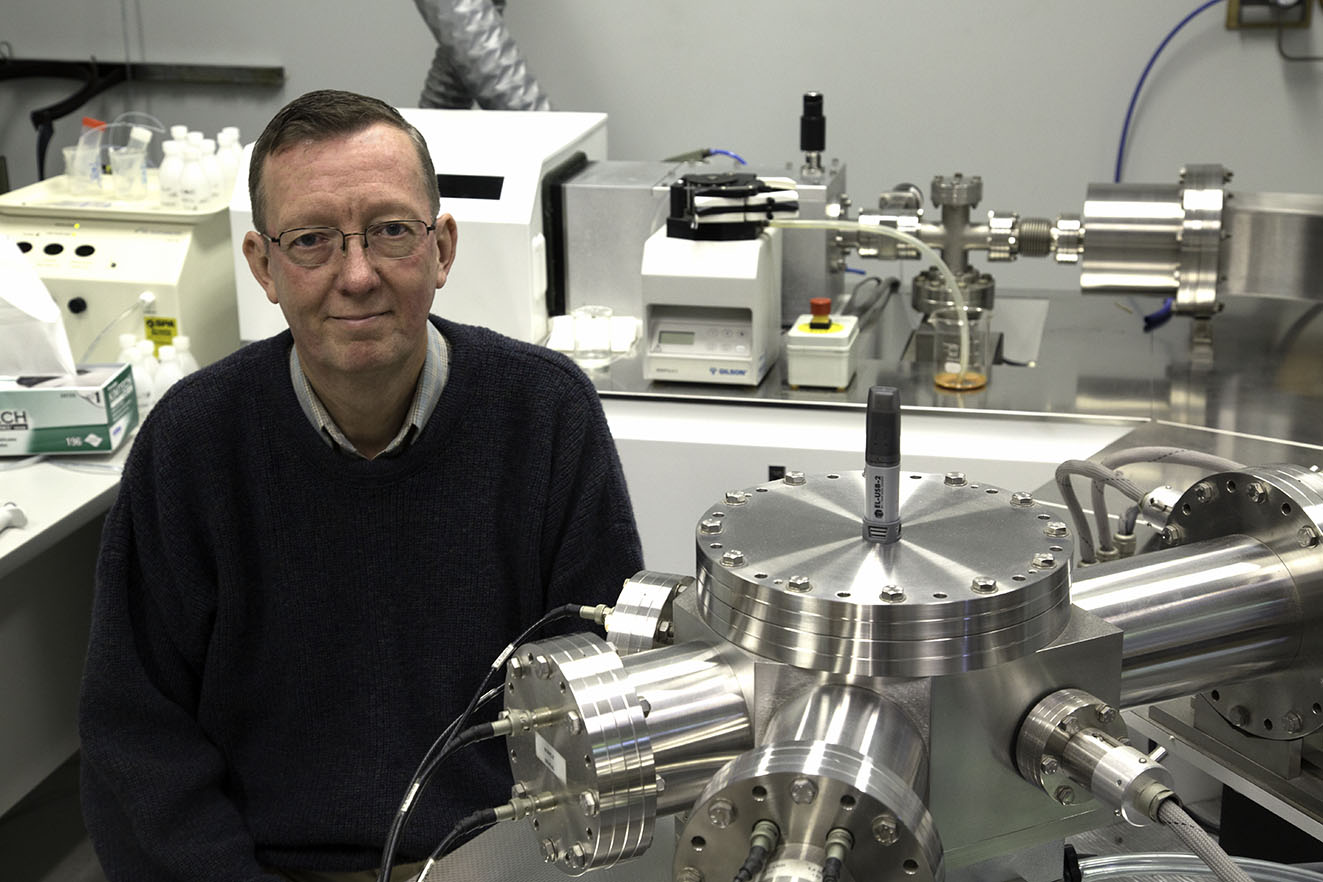
Norman Pearson with the Nu Plasma II MC-ICP-MS, installed in June 2015.
Progress in 2015 included:
The Nu Plasma II MC-ICP-MS was installed in June 2015 following the decommissioning of Nu Plasma 005 after 16 years of service. The second generation Nu Plasma has an expanded collector array (16 Faraday cups and 5 ion counters) and enhanced sensitivity compared to the older instruments, which have already led to improvements in a variety of in situ techniques (e.g. U-Pb in zircon, Re-Os in sulfides) and stable metal isotopes (e.g. Mg).
Upgrade to Nu Plasma HR 034: A new enhanced interface was installed as part of an upgrade of this 11 year-old instrument in June 2015. The upgrade has increased sensitivity between 1.5 and 2 times, and this has contributed to an overall improvement in the precision of single measurements and long-term reproducibility.
Photon Machines Excite 193nm laser system: In 2015 a third excimer laser microprobe was installed and co-located with one of the Nu Plasma MC-ICP-MS to establish the laser ablation split-stream infrastructure.
Split-stream analysis: The development of the split-stream methods was postponed until the Nu Plasma II was installed due to performance issues with Nu Plasma 005. Preliminary experiments indicate that sensitivity will be a critical issue for the viable simultaneous analysis of U-Pb and Hf isotopes in zircon.
Development of new sample preparation methods for geochemical and isotope analysis: New methods developed for the analysis of radiogenic isotopes (Rb-Sr, Sm-Nd and Lu-Hf) at ultra-low levels and/or small sample volumes were applied to mantle peridotites and pyroxenites (Nicole McGowan PhD, Romain Tilhac PhD, Jianggu Lu PhD). The development of Mg isotope methodologies for chromite and chromite-rich ultramafic rocks as part of the TARDIS Program (Nicole McGowan PhD) was completed; high-precision results were obtained in wet-plasma mode on the Nu Plasma II and corroborated by replicate measurements at IGGCAS, Beijing.
Evaluation of standard reference materials (silicate) for combined measurement using laser ablation ICP-MS and MC-ICP-MS: The development of potential microbeam standards for combined laser ablation ICP-MS and MC-ICP-MS requires characterisation of the chemical (major and trace elements) and isotopic compositions. Approaches taken are:
• investigation of U-Pb geochronology of zircon by femtosecond laser ablation
• investigation of ablation processes of sulfides using Excimer and femtosecond laser systems
• assessment of a variety of common-Pb bearing accessory minerals (e.g. apatite, rutile, titanite) for U-Pb geochronology
• on-going development of garnet standards for in situ measurement of Mg isotopes (laser ablation MC-ICPMS and SIMS; in collaboration with Prof Jin-hui Yang and Prof Fu-Yuan Wu at IGGCAS, Beijing) and O isotope composition (SIMS development in collaboration with UWA-CMCA).
Incorporation of operating protocols for combined laser ablation ICP-MS and MC-ICP-MS data into GLITTER data reduction software: Revision of GLITTER
continued in 2015 to enable the simultaneous treatment of combined trace-element and isotope ratio measurements. Glitter support for output from the Nu
Plasma II has been implemented and plans to add radiogenic isotope systems such as Lu-Hf, Re-Os, Nd-Sm and
Rb-Sr have commenced.
Published outputs for 2015
2 Conference Abstracts

 ARC Centre of Excellence for Core to Crust Fluid Systems
ARC Centre of Excellence for Core to Crust Fluid Systems